Toyota Venza: Front passenger occupant classification system
Your vehicle is equipped with a front passenger occupant classification system. This system detects the conditions of the front passenger seat and activates or deactivates the devices for front passenger.
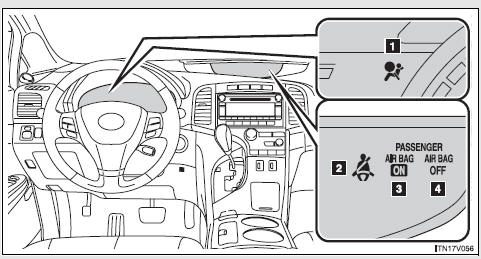
1. SRS warning light
2. Front passenger’s seat belt reminder light
3. “AIR BAG ON” indicator light
4. “AIR BAG OFF” indicator light
Condition and operation in the front passenger occupant classification system
- Adult*1
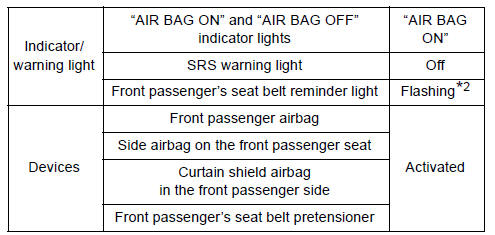
- Child*3 or child restraint system*4
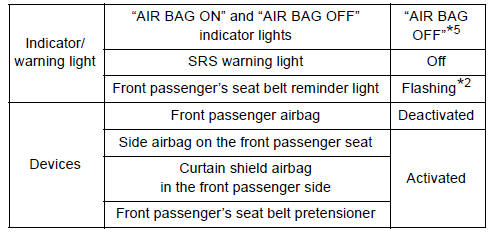
- Unoccupied
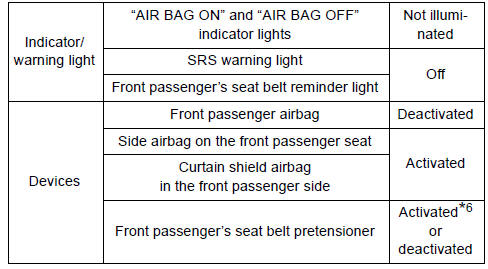
- System malfunction
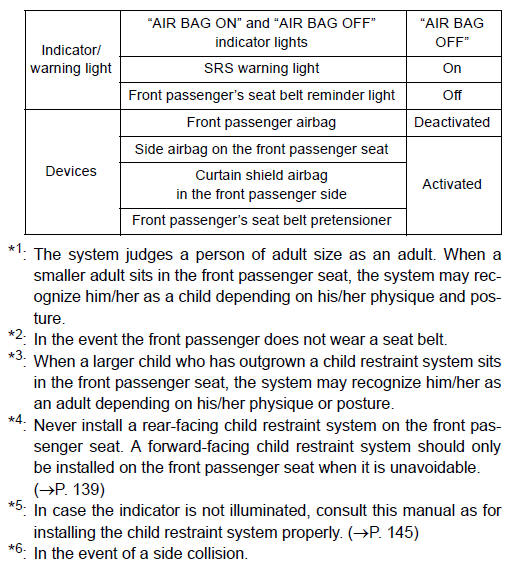
CAUTION
- Front passenger occupant classification system precautions
Observe the following precautions regarding front passenger occupant classification system.
Failure to do so may cause death or serious injury.
• Wear the seat belt properly.
• Make sure the front passenger’s seat belt tab has not been left inserted into the buckle before someone sits in the front passenger seat.
• Make sure the “AIR BAG OFF” indicator light is not illuminated when using the seat belt extender for the front passenger seat. If the “AIR BAG OFF” indicator light is illuminated, disconnect the extender tongue from the seat belt buckle, then reconnect the seat belt. Reconnect the seat belt extender after making sure the “AIR BAG ON” indicator light is illuminated. If you use the seat belt extender while the “AIR BAG OFF” indicator light is illuminated, the SRS airbags for the passenger may not activate correctly, which could cause death or serious injury in the event of collision.
• Do not apply a heavy load to the front passenger seat or equipment (e.g.
seatback pocket).
• Do not put weight on the front passenger seat by putting your hands or feet on the front passenger seatback from the rear passenger seat.
• Do not let a rear passenger lift the front passenger seat with their feet or press on the seatback with their legs.
• Do not put objects under the front passenger seat.
CAUTION
- Front passenger occupant classification system precautions
• Do not recline the front passenger seatback so far that it touches a second seat. This may cause the “AIR BAG OFF” indicator light to be illuminated, which indicates that the passenger’s airbags will not deploy in the event of a severe accident. If the seatback touches the second seat, return the seatback to a position where it does not touch the second seat. Keep the front passenger seatback as upright as possible when the vehicle is moving.
Reclining the seatback excessively may lessen the effectiveness of the seat belt system.
• If an adult sits in the front passenger seat, the “AIR BAG ON” indicator light is illuminated. If the “AIR BAG OFF” indicator is illuminated, ask the passenger to sit up straight, well back in the seat, feet on the floor, and with the seat belt worn correctly. If the “AIR BAG OFF” indicator still remains illuminated, either ask the passenger to move to the rear seat, or if that is not possible, move the front passenger seat fully rearward.
• When it is unavoidable to install the forward-facing child restraint system on the front passenger seat, install the child restraint system on the front passenger seat in the proper order.
• Do not modify or remove the front seat.
• Do not kick the front passenger seat or subject it to severe impact. Otherwise, the SRS warning light may come on to indicate a malfunction in the detection system. In this case, contact your Toyota dealer immediately.
• Child restraint systems installed on the rear seat should not contact the front seatbacks.
• Do not use a seat accessory, such as a cushion or seat cover, that covers the seat cushion surface.
• Do not modify or replace the upholstery of the front seat.
 SRS airbags
SRS airbags
The SRS airbags inflate when the vehicle is subjected to certain types of
severe impacts that may cause significant injury to the occupants. They work together
with the seat belts to help reduce t ...
 Child restraint systems
Child restraint systems
A child restraint system for a small child or baby must itself be properly
restrained on the seat with the lap portion of the lap/shoulder belt.
The laws of all 50 states of the U.S.A. and Canada n ...
Other materials about Toyota Venza:
Front Passenger Side Power Mirror cannot be Adjusted with Power Mirror Switch
SYSTEM DESCRIPTION
When the mirror adjust switch is operated, the main body ECU (driver side junction
block assembly) detects the switch operation and sends the mirror adjust switch
signal to the outer mirror control ECU assembly (front passenger door) vi ...
Terminals Of Ecu
TERMINALS OF ECU
1. CHECK POWER BACK DOOR ECU (POWER BACK DOOR MOTOR UNIT)
(a) Disconnect the L20 ECU connector.
(b) Measure the voltage and resistance according to the value(s) in the table
below.
Tester Connection
Wiring Color
...
USB Media Malfunction (B1585)
DESCRIPTION
This DTC is stored when a malfunction occurs in a connected device.
DTC No.
DTC Detection Condition
Trouble Area
B1585
When any of the following conditions is met:
A non m ...
0.1608
